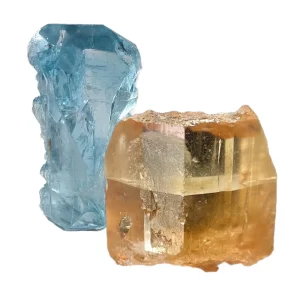
Topaz is a luminous gemstone celebrated for its wide range of vibrant colors and its connection to clarity, strength, and abundance. Naturally occurring in hues such as golden yellow, pale blue, pink, peach, green, and clear (colorless), topaz has been admired since antiquity for both its beauty and metaphysical attributes.
History & Lore
The name “topaz” is believed to have originated from the ancient Greek Topazios, an island in the Red Sea (now known as Zabargad), though this was likely a source of peridot, which was historically mistaken for topaz. Throughout history, topaz has been linked to the sun, used as a talisman of protection and healing by ancient Egyptians, Romans, and medieval mystics.
The most iconic variety is Imperial Topaz, a rich golden to reddish-orange gem once reserved for the Russian czars. Blue topaz, though relatively rare in nature, is now widely available thanks to irradiation and heat treatments that turn clear topaz into brilliant shades of sky, Swiss, or London blue. Mystic topaz, a modern variety with a rainbow-like coating, adds a contemporary twist to this ancient stone. As the birthstone for November (and an alternate for December), topaz symbolizes warmth, good fortune, and the power to transform negative energy into strength and positivity.
Meaning & Symbolism
In metaphysical traditions, topaz is seen as a stone of truth and manifestation. It is thought to align the wearer’s energy with their intentions, helping to clarify goals and attract abundance. Yellow and golden topaz are especially associated with the solar plexus chakra, promoting confidence, willpower, and emotional resilience. Blue topaz is linked to the throat chakra, supporting clear communication, inner peace, and expression of one’s truth. Across all varieties, topaz is believed to soothe tension, inspire creativity, and restore balance—making it a versatile stone for emotional and spiritual support.
Origin & Regionality
Topaz is found in many parts of the world, often forming in igneous rocks such as granite and rhyolite or in alluvial deposits where it has weathered out of its original host. Brazil is the most significant source of topaz today, especially the Minas Gerais region, which produces a wide spectrum of colors, including the coveted Imperial Topaz. Russia was historically famous for topaz, particularly from the Ural Mountains, which yielded fine golden and pink specimens.
Pakistan and Afghanistan produce beautiful pink, peach, and colorless topaz, often found in high-altitude pegmatite veins. Sri Lanka is known for its pale blue and yellow varieties, often recovered from river gravels. Nigeria and Myanmar also offer a variety of colors, while Mexico yields vivid orange and reddish-brown stones. In the United States, topaz is found in Utah, Texas, and Colorado, with some gem-quality stones found in volcanic rock formations.
With its rich palette and broad availability, topaz offers something for every taste and purpose—from bold statement pieces to subtle spiritual tools. Its shimmering clarity and deep historical roots make it a gemstone of both beauty and meaning.


